Board hit evaluation
One of PokerRanger2's most powerful feature is the potential evaluation of boards against player ranges. You can easily evaluate how one or two players hit a specific flop, turn, or river. What's more PokerRanger also offers to get an equity evaluation for each particular hand type.
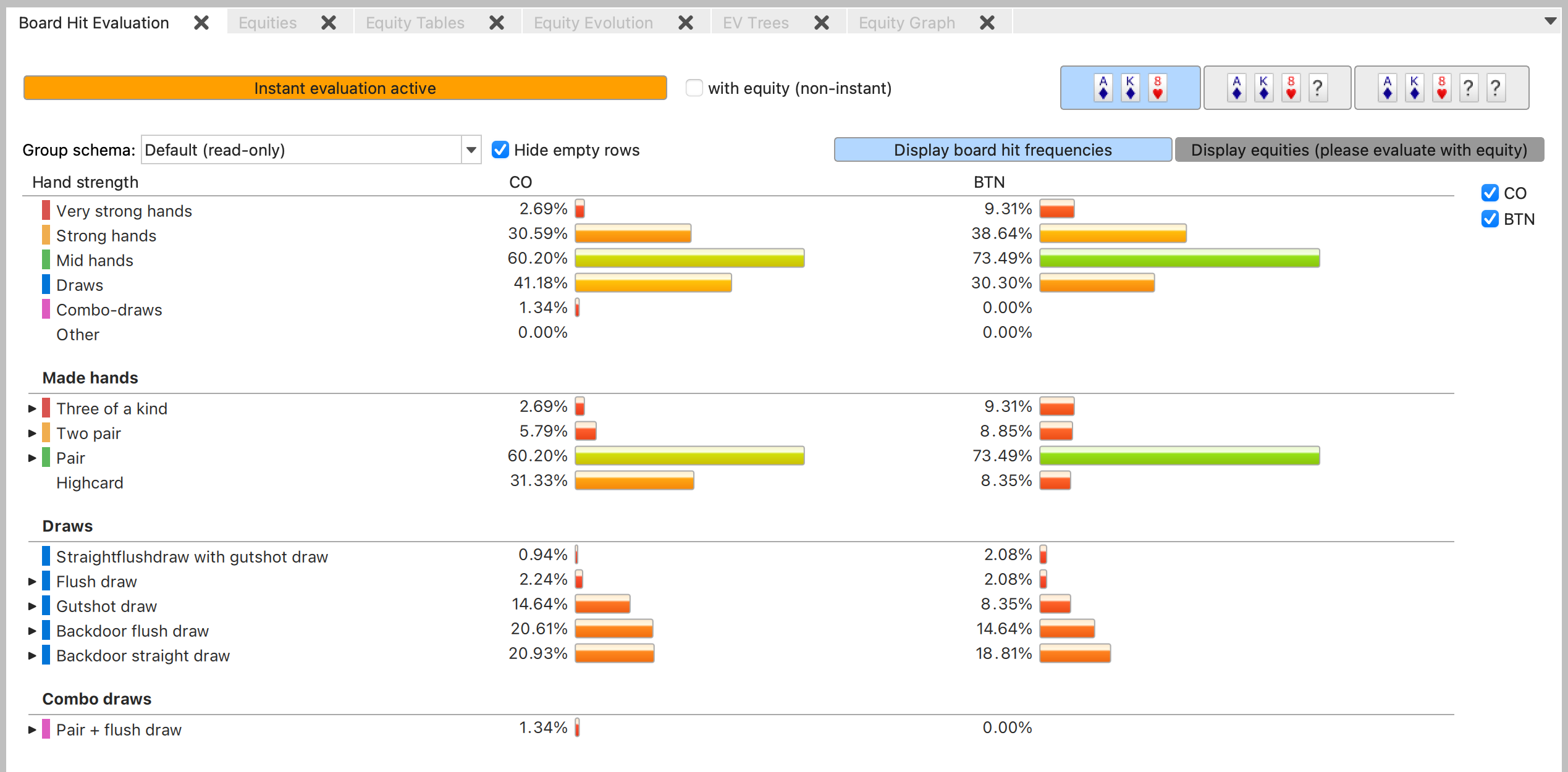
This is the overview of hand types that is used per default. In the following we will go through all of the particular controls in detail.
Evaluate hand types button

This button takes on different shapes and texts. When only two players are about to evaluated without equity, "instant evaluation" is active which means that any board/player range change updates the overview, this is shown by the text on the button.
If more players are selected or you want to also calculate equities, the button needs to be pressed.

Note that this starts a monte carlo simulation because the results are too complex to evaluate in a timely manner. PokerRanger2 is the only tool that gives you equity results for each hand category as opposed to tools like Power Equilab or Flopzilla Pro. You can stop the simulation at each point in time by clicking on the button again.
With equity

If this checkbox is enabled, the next evaluation will also calculate equities. These are shown at different places. For once, you can now use the "Display equities" button (described below). Also, a tooltip shows the equity for each hand category:
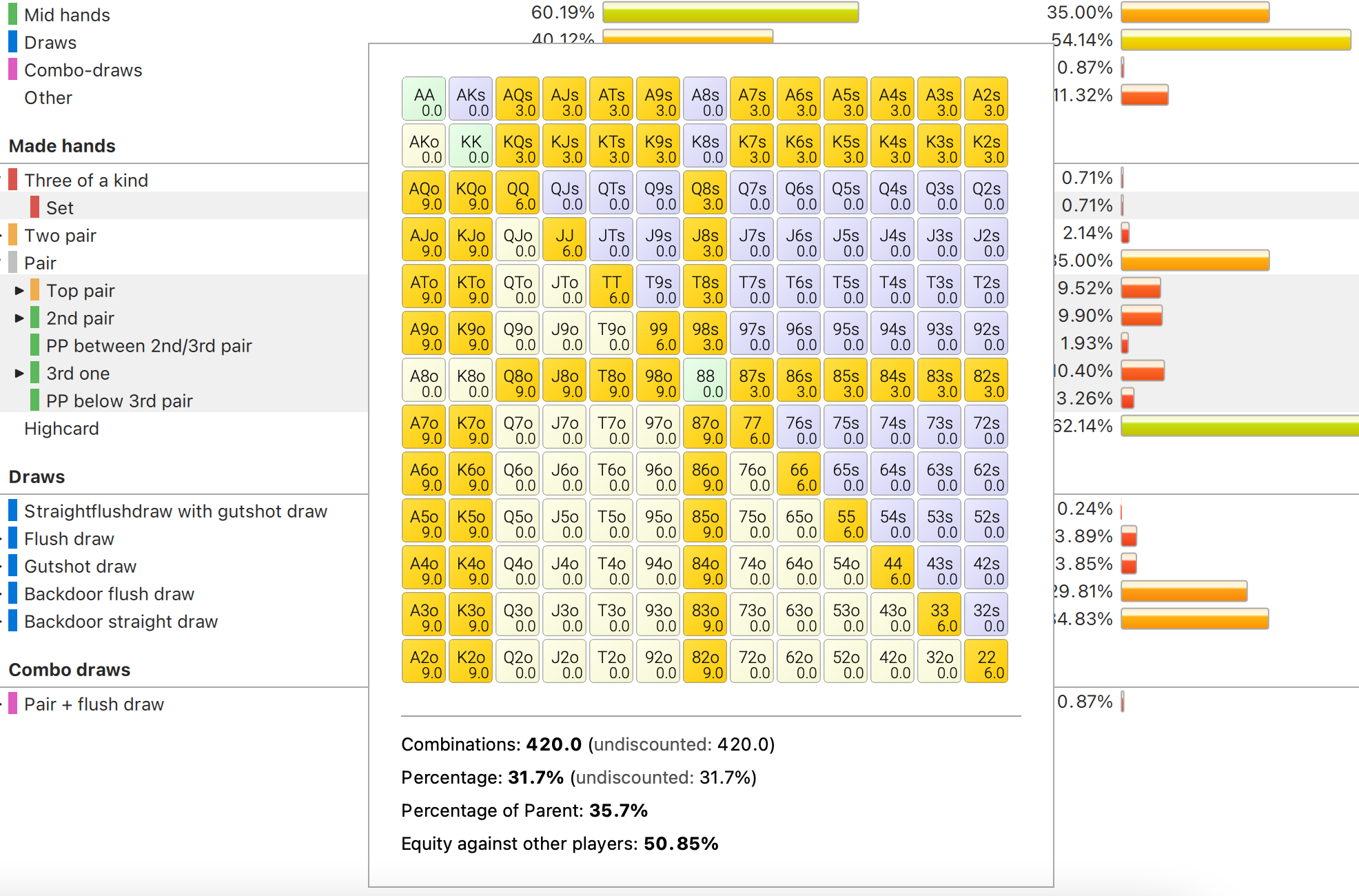
In this screenshot, we hovered "Mid hands" of the 2nd player. We get an overview of all the hands that are in this category, the number of combinations, the percentage of hands (overall), the percentage of parent hands, and the equities against other players, which turns out to be 50.85%. The percentage of hands is 31.7% which is just 420 divided by 1326 (1326 is all combinations possible in Texas Hold'em). By the way: "Percentage of parent" (35.7%) would be the same as the 35% shown in the bar graph itself, but it neglects discounts by other player's ranges (that clearly have an effect) meaning that this number just shows this stats value in isolation. It could also make a difference if you use random cards because then the matrix shows all hands that could in any of the random card occurences happen. Equity, as always, is the weighted average and takes all occurences into account.
Flop/turn/river selection with random cards

The fixed (non-random) cards need to be selected in the global "Board Cards" widget. They will be copied into this dialog. In this case, we have selected "AdKd8h". You can now choose between three options:
- Evaluate AdKd8h just as it is: Which hand types do players hit here? For example, AA would have a set here
- Evaluate AdKd8h with a random card: This evaluates a turn while the fourth card is random. For example, a hand like 3d2d would have a flush here sometimes (if the random card is a diamond) and sometimes not. All the potential turns are averaged.
- Evaluate AdKd8h with two random cards: This evaluates a river while the fourth and fifth card are random. For example, a hand like Td2s could have straight flush quite rarely when turn and river become QdJd. Again, all results are averaged. As two perfect cards on turn and river are very unlikely, the chance for having a straight flush with Td2s on this random river is quite low.
If you do not enter any board card, you can also evaluate purely random flops, turns, or rivers. If you enter four cards, you can evaluate fixed turns or, alternatively, rivers where the fifth card is random. If you define five board cards, you can only evaluate the deterministic river.
Group schema

This dropdown allows you to select the schema for which hands are grouped. By default, the "Default (read-only)" schema is selected which puts Set/three of a kind, flush, straight, full house, four of a kind, and straight flush into the category of "Very strong hands" (excluding board flush and board straight), two pairs, top pairs, and overpairs into the category of "Strong hands" (again excluding board ones), other pairs into "Mid hands", and draws into "Draws". There is also a category for "combo draws". Depending on where you use this group, this will only grab hands if they are not in another category. By default, you will not see it in "Equity graphs with groups", for example.
We discuss more on the group schemas in a dedicated article about it:
Group schemas
Empty groups

Hide groups where no hand of a player has a hit. This creates more overview. When you want to modify hand categories, you might want to disable this option to see all the options. A better place to do this is to use the "Group schema edit dialog", though.
Display board hit frequencies or equities

This switch allows you to toggle between showing board hit frequencies and equities. "Display equities" is only available if you made the evaluation using the "with equity (non-instant)" checkbox. Otherwise, equities are not calculated to get a high-speed output. Displaying equities is a feature that only PokerRanger offers in this way.
For example, let's say we have selected a 30% range for player1 (CO) and a random (100% range) for player2 (BTN) and we evaluate the board  .
.
Using "display board hit frequencies" shows us:
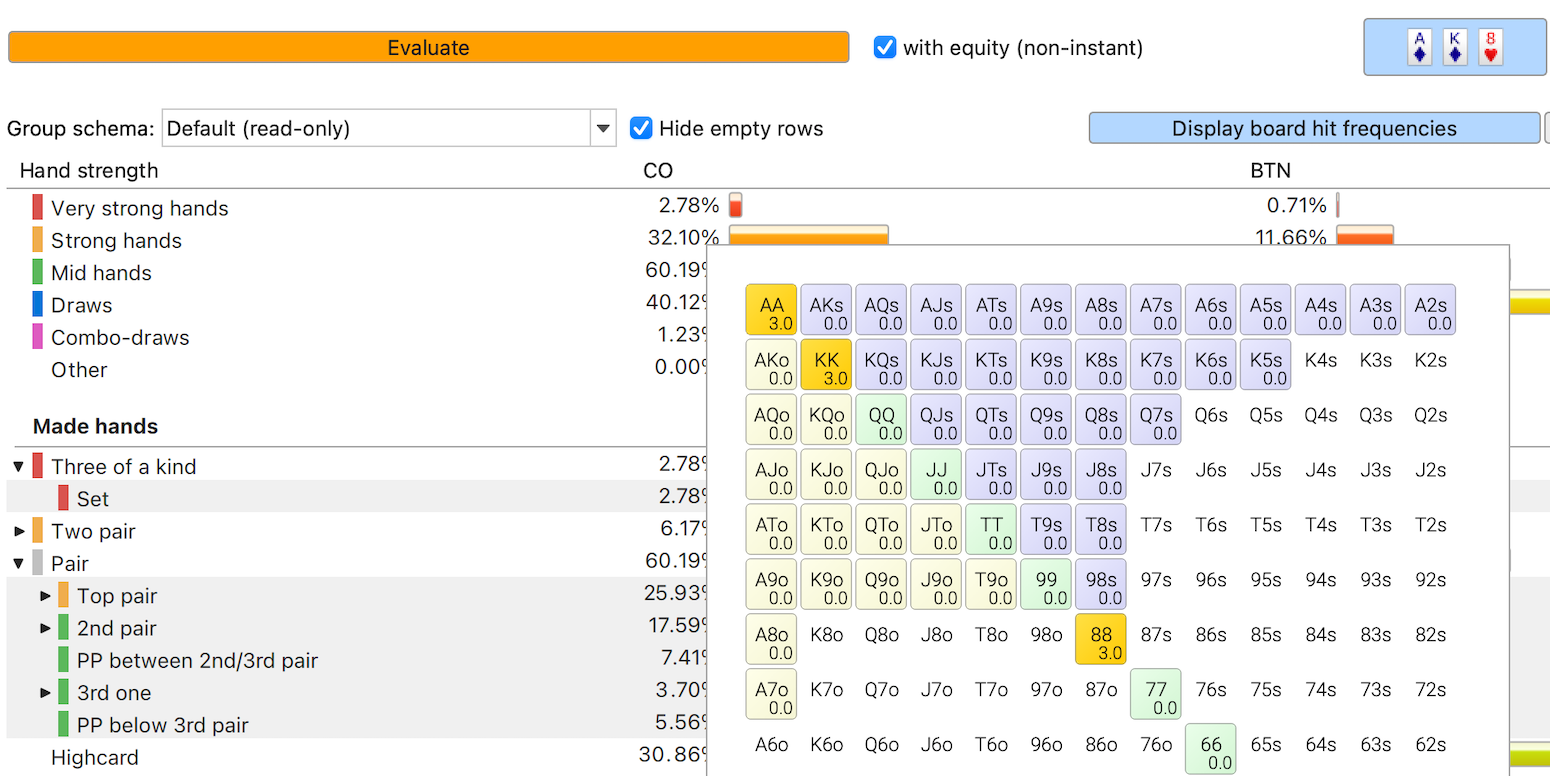
Hovering "Very strong hands" shows us that only AA, KK, and 88 are "very strong" here because only these hit a set (or stronger). Straights, flushs, and so on are not possible here. PokerRanger also tells us that only 2.78% of times such hands are hit.
If we now change the toggle to "Display equities", we get a different picture:
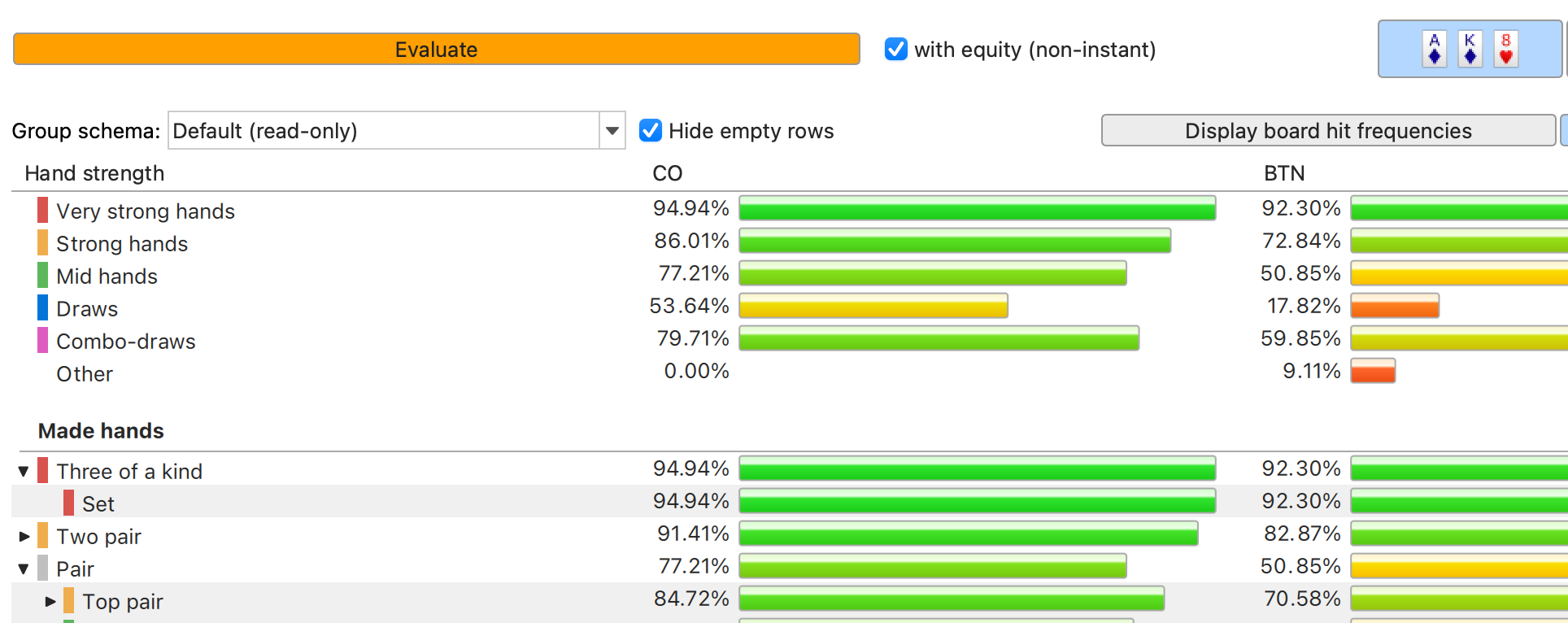
As can be seen, these "very strong hands" have very high equity (94.94%) which is not surprising. As very strong hands only include sets at the moment, we can also see below that "Three of a kind" and "Set" also have 94.94% equity. With this function, we see equities for all of the different hand types.
Selected players
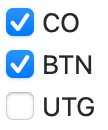
On the right-hand side of the "Board hit evaluation" tab you can see all the players that have some hands within their range. In this case, we have selected CO and BTN but not UTG. This means that UTG has some hands in his range but we only want to evaluate CO and BTN. If we select two players, the equities of CO vs BTN are evaluated. If we select three players, the equities of CO vs BTN vs UTG (three-way) are evaluated. PokerRanger combines multi-way equity calculation with board hit evaluations. As soon as more than two players are selected, the "instant evaluation" button needs to be pressed by yourself and can be stopped with a second click when you feel that the precision is high enough.
Context menu
There is quite a powerful context menu that can be easily missed if you don't know about it. It can be used if you would like to reuse ranges that come out of the board hit evaluation dialog.

In this example, we right-clicked on "Very strong hands", which allows us to reuse these very strong hands (here AA,KK,88 to follow above example). We can add CO's hands to "CO range" (this does not make a difference in this example). We can also choose to remove the very strong hands from CO's range. We can replace the entire range with AA,KK,88. The last option might be most interesting: You can choose to create a group below CO's range "Very strong hands" that contains these hands:
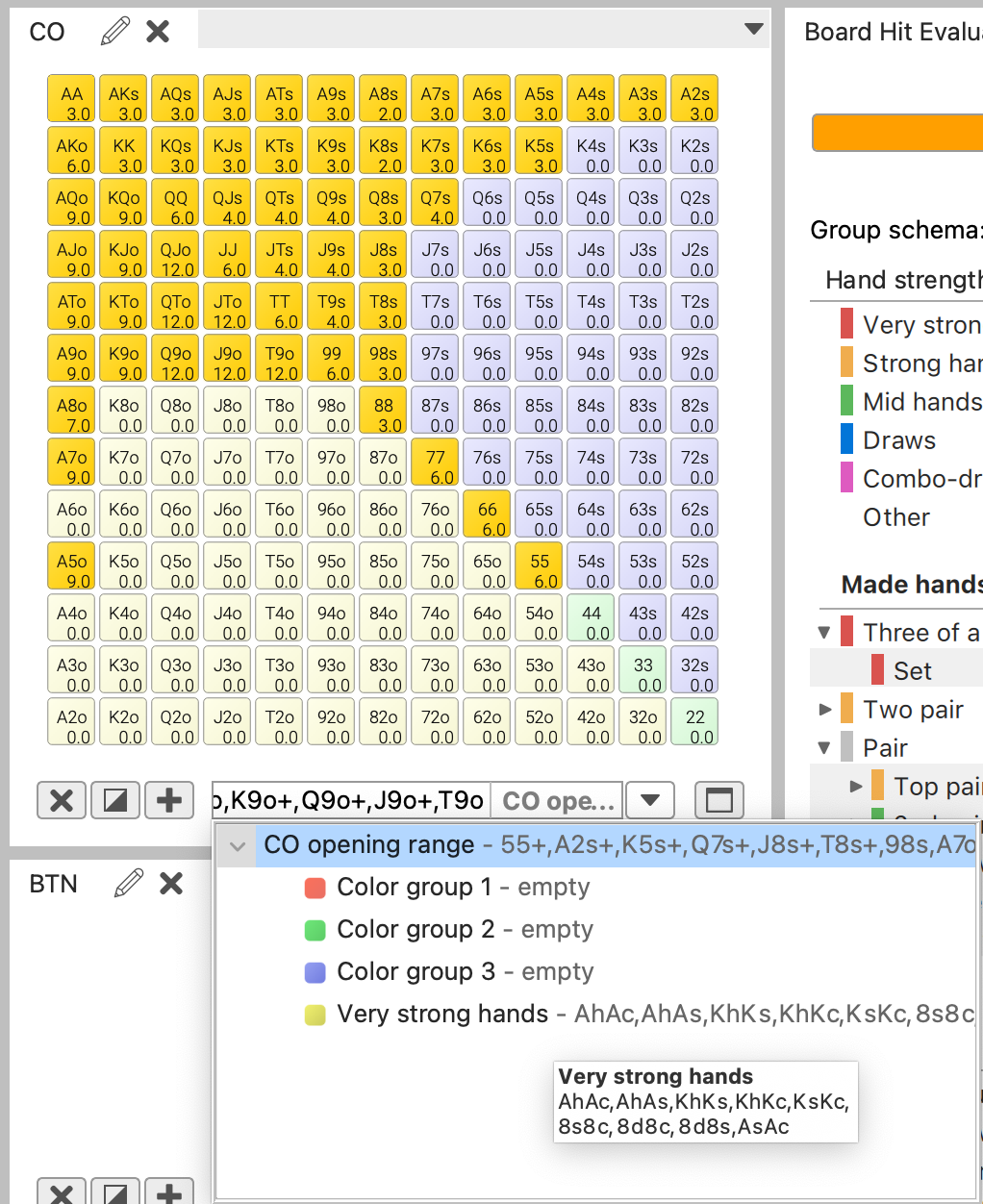
As you can see the dropdown has a new group "Very strong hands" which contains our sets. Of course, you can select this group and then the board hit evaluation tab will automatically analyse this new subrange to create further analyses and so on.
If you have any further questions regarding hand group schemas, do not hestitate to contact our support anytime! We are glad to help via Discord, Skype, mail or any other way.